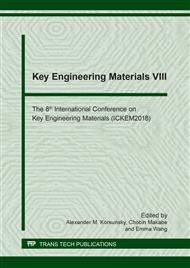[1]
Vodela JK, Renden JA, Lenz SD, Henney WHM, Kemppainen BW. Drinking water contaminants (Arsenic, cadmium, lead, benzene, and trichloroethylene) 1. Interaction of contaminants with nutritional status on general performance and immune function in broiler chickens. Pollution Science. 76 (1997).
DOI: 10.1093/ps/76.11.1474
Google Scholar
[2]
Öztürk M, Özözen G, Minareci O, Minareci E. Determination of heavy metals in fish, water and sediments of Avsar Dam Lake in Turkey. Iran J Environ Health Sci Eng. 6 (2009) 73–80.
Google Scholar
[3]
Bhattacharyya MH, Wilson AK, Rajan SS, Jonah M (2000) Biochemical pathways in cadmium toxicity. In: Zalups RK, Koropatnick J (Eds), Molecular biology and toxicology of metals, Taylor and Francis, London, p.34–74.
Google Scholar
[4]
H. Abu Qdaisa, H. Moussab, Removal of heavy metals from wastewater by membrane processes: a comparative study, Desalination. 164 (2004), 105-110.
DOI: 10.1016/s0011-9164(04)00169-9
Google Scholar
[5]
S. Babel, T.A. Kurniawan Cr(VI) removal from synthetic wastewater using coconut shell charcoal and commercial activated carbon modified with oxidizing agents and/or chitosan, Chemospher., 54 (7) (2004), 951-967.
DOI: 10.1016/j.chemosphere.2003.10.001
Google Scholar
[6]
C. Bloocher, J. Dorda, V. Mavrov, H. Chmiel, N.K. Lazaridis, K.A. Matis, Hybrid flotation-membrane filtration process for the removal of heavy metal ions from wastewater, Water Res., 37 (2003), 4018-4027.
DOI: 10.1016/s0043-1354(03)00314-2
Google Scholar
[7]
H.A. Essawy, H.S. Ibrahim, Synthesis and characterization of poly(vinylpyrrolidone-co- methylacrylate) hydrogel for removal and recovery of heavy metal ions from wastewater. React. Funct. Polym., 61 (2004), 421-432.
DOI: 10.1016/j.reactfunctpolym.2004.08.003
Google Scholar
[8]
D. Fenga, C. Aldrich, Adsorption of heavy metals by biomaterials derived from the marine alga Ecklonia maxima. Hydrometallurgy, 73 (2004), 1-10.
DOI: 10.1016/s0304-386x(03)00138-5
Google Scholar
[9]
V.K. Gupta, C.K. Jain, I. Ali, M. Sharma, S.K. Saini, Removal of cadmium and nickel from wastewater using bagasse fly ash – a sugar industry waste.Water Res., 37 (2003), 4038-4044.
DOI: 10.1016/s0043-1354(03)00292-6
Google Scholar
[10]
J. Lv, K.Y. Wang, T.S. Chung, Investigation of amphoteric polybenzimidazole (PBI) nanofiltration hollow fiber membrane for both cation and anions removal. J. Membr. Sci., 310 (2008), 557-566.
DOI: 10.1016/j.memsci.2007.11.050
Google Scholar
[11]
V.M. Gun'ko, I.N. Savina, S.V. Mikhalovsky, Cryogels: Morphological, structural and adsorption characterization. Advances in Colloid and Interface Science, 187–188 (2013), 1-46.
DOI: 10.1016/j.cis.2012.11.001
Google Scholar
[12]
L. Onnby , C. Giorgi , F.M. Plieva, B. Mattiasson, Removal of heavy metals from water effluents using supermacroporous metal chelating cryogels. Biotechnol Prog. 26(5) (2010) 1295-1302.
DOI: 10.1002/btpr.422
Google Scholar
[13]
V.I Lozinsky, Cryogels on the basis of natural and synthetic polymers: preparation, properties and application Russian Chemical Reviews,71(6) (2002), 489.
DOI: 10.1070/rc2002v071n06abeh000720
Google Scholar
[14]
D. Ceylan, M. M. Ozmen, and O. Okay, Swelling–deswelling kinetics of ionic poly(acrylamide) hydrogels and cryogels. J. Appl. Polym. Sci., 99 (2006) 319-325.
DOI: 10.1002/app.22023
Google Scholar
[15]
S. Gorgieva, V. Kokol Processing of gelatin-based cryogels with improved thermomechanical resistance, pore size gradient, and high potential for sustainable protein drug release March Journal of Biomedical Materials Research Part A 103(3) (2015).
DOI: 10.1002/jbm.a.35261
Google Scholar
[16]
Kirsebom, Harald, et al. Enzyme‐Catalyzed Crosslinking in a Partly Frozen State: A New Way to Produce Supermacroporous Protein Structures., Macromolecular bioscience 13.1 (2013): 67-76.
DOI: 10.1002/mabi.201200343
Google Scholar
[17]
Doretti L.,Ferrara D., gattoline P., Lora S., Schiavon F., and Veronese F.M. (1998). PEG-modified glucose oxidase immobilized on a PVA cruogel membrane for amperometric biosensor applications. Talanta 45(5): 891-898.
DOI: 10.1016/s0039-9140(97)00191-4
Google Scholar
[18]
D. Berillo, B. Mattiasson, and H. Kirsebom, Cryogelation of chitosan using noble-metal ions: in situ formation of nanoparticles. Biomacromolecules 15(6) (2014) 2246-2255.
DOI: 10.1021/bm5003834
Google Scholar
[19]
O. Zaushitsyna, , et al. Cryostructured and crosslinked viable cells forming monoliths suitable for bioreactor applications. Topics in Catalysis 57(5) (2014) 339-348.
DOI: 10.1007/s11244-013-0189-9
Google Scholar
[20]
D. Çimen, D. Türkmen and A. Denizli, Poly-L-Histidine Attached Poly(glycidyl methacrylate) Cryogels for Heavy Metal Removal. Journal of Macromolecular Science, Part A, 52:9 (2015), 724-731.
DOI: 10.1080/10601325.2015.1063868
Google Scholar
[21]
N. Sahiner, S. Demirci, M. Sahiner, S. Yilmaz,H. Al-Lohedan, The use of superporous p(3-acrylamidopropyl)trimethyl ammonium chloride cryogels for removal of toxic arsenate anions. Journal of Environmental Management 152 (2015) 66-74.
DOI: 10.1016/j.jenvman.2015.01.023
Google Scholar
[22]
L. Önnby, H. Kirsebom, Cryogel-supported titanate nanotubes for waste treatment: Impact on methane production and bio-fertilizer quality. Journal of Biotechnology 207 (2015) 58-66.
DOI: 10.1016/j.jbiotec.2015.05.014
Google Scholar
[23]
L. Doretti, D. Ferrara, S. Lora, F. Schiavon and F.M. Veronese, Acetylcholine biosensor involving entrapment of acetylcholinesterase and poly (ethylene glycole)-modified chilone oxidase in a poly (vinyl alcohol) cryogel membrane. Enzyme and Microbial Technology 27(3) (2000).
DOI: 10.1016/s0141-0229(00)00210-6
Google Scholar
[24]
M. Kurozumi, Y. Yano, S. Kiyoyama, A. Kumar and K. Shiomori, Adsorption properties of arsenic(v) by polyacrylamide cryogel containing iron hydroxide oxide particles prepared by in situ method. Resources Processing 62 (2015) 17–23.
DOI: 10.4144/rpsj.62.17
Google Scholar
[25]
S. Abdurrahmanoglu, V. Can, O. Okay, Equilibrium swelling behavior and elastic properties of polymer-clay nanocomposite hydrogels. J. Appl. Polym. Sci. 109 (2008) 3714-3724.
DOI: 10.1002/app.28607
Google Scholar


